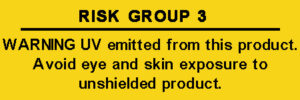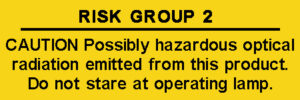LED Safety – Microscope Adapter and Flashlights
NIGHTSEA uses light-emitting diodes (LEDs) in the fluorescence excitation light heads for the Stereo Microscope Fluorescence Adapter and in the Xite and DFP flashlights. They are focused to produce strong illumination of your subjects, but they are NOT lasers and there is no danger of instantaneous eye damage from looking directly into the light. In all cases, the intended use is that the light source is directed at a sample or surface to be examined, and the fluorescence is viewed through the filters/filter glasses provided by NIGHTSEA for use with each particular light source. When used in this way the eye and skin exposure to the light source is close to zero, other than incidental reflections.
There are some reasonable LED safety precautions that should be taken in their use. We will outline those first here, then provide more detail below.
General safety precautions
- Do not stare directly into any of the light sources.
- Do not point any of the light sources into anyone else’s eyes.
- Always use the filter material, whether filter glasses or microscope barrier filter and shield, supplied with and matched to each light and filter set.
- If you or anyone nearby are bothered by bright reflections you can use an opaque object, such as a sheet of cardboard, to make a shield.
- We have had rare anecdotal reports of individuals who are especially sensitive to blue light, reporting headaches or other effects after periods of exposure. This appears to be individual and not general. If you are affected by any of the light sources you should take extra precautions to avoid exposure. This could include use of barrier filter glasses. We can supply these in any of the wavelengths used in the SFA system.
Wavelengths
We currently offer five excitation source options:
- UV – Ultraviolet – ~360 – 380nm
- VI – Violet – ~400 – 415nm
- RB – Royal Blue, ~440 – 460nm
- CY – Cyan, ~490 – 515nm
- GR – Green, ~510 – 540nm
There are no known dangers of exposure to the eye or skin for the CY and GR sources.
The VI and RB sources are not known to have erythemal (skin) effects but may have photochemical effects on the retina for long exposure times. We will discuss this further below.
The UV sources could potentially have both eye and erythemal effects with extended direct exposure. This can be avoided by following the General Safety Precautions outlined above.
LED testing for photobiological safety
We have had the NIGHTSEA light sources tested by a Certified Body according to the guidance of IEC 62471. The testing was done for the worst-case condition of direct exposure to the light (i.e., staring into it or pointed at the skin) from a distance of 200mm (~8″). While the greatest known potential dangers are from the Ultraviolet and Royal Blue wavelengths, for an abundance of caution we have labeled all of the lights in the same way to encourage safe use of the products. LED rating and marking is as follows:
- UV warning label
- VI, RB, CY, GR warning label
Remember – this is worst-case for direct exposure, which is not how the products are used. When used according to the intended use and the instructions provided with the products, actual exposure to the LED output is minimal.
Aversion response
We are usually protected from extended exposure to bright light sources by our natural aversion response. When exposed to a bright source we tend to look away quickly. The perceived brightness of a source is related to its wavelength, as described by its luminous efficacy. Our eyes are not equally sensitive to all wavelengths (colors) of light, so that two light sources of equal energy but different wavelength will produce different sensations of brightness. The maximum brightness response is in the green, at 555nm.
Royal Blue – The luminous efficacy at the wavelength range of the Royal Blue source is only about 10% of the maximum. The RB sources are still bright enough to produce an aversion response, but they are even more intense than they appear.
Violet and Ultraviolet – The luminous efficacy for the Violet source is very low and for the Ultraviolet it is zero, which is why ultraviolet light is also called ‘black light’ – it is there, but you can’t see it with the naked eye. The important point is that these light sources do not produce an aversion response so it is necessary to know that you should not stare into them.
Blue light hazard
The topic of ‘blue light hazard‘ is being considered a lot these days because of the white LED lights that are increasingly replacing conventional filament light bulbs. At the heart of white LED lights are really Royal Blue LEDs with a phosphor that absorbs much of the blue and emits a broad range of wavelengths to produce the sensation of white light. Some of the blue peak remains.
We are exposed to blue light all the time: from sunlight, from overhead fluorescent lights, in fact from any white light source. The danger, if any, would seem to come from extended eye exposure to bright sources of blue light. The best precaution is to minimize that exposure by following the general safety precautions outlined above.


